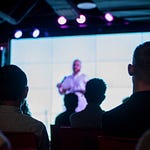Hey my friends,
It feels surreal to be sending you this edition of Tech Tuesday in the afterglow of releasing my first novel - Synthetic Eden - this morning. If you’ve been following along, you know the story has been in my head for years, sitting at the intersection of science, technology, and the impossible-to-shake questions about what it means to be human. But until recently, I never imagined I’d find myself writing fiction—let alone publishing a 135,000-word novel, the first of a four-book series.
And I didn’t do it alone.
This week, I want to take you behind the scenes of my collaboration with Sean Platt—a science fiction writer who has penned more books than I’ve read in some years, and who has taught me that story can be the most powerful laboratory we have. Our conversation (which you can listen to on the TCIP podcast, above) turned into an origin story of sorts—not just for Synthetic Eden and the entire Echoes of Tomorrow series, but for the way I now think about science, ethics, and fiction as partners in progress.
Thank you for opening a public dialogue on science, tech, and the social and systems challenges we are facing through your creative arts. I’m a big fan.
-Synthetic Eden fan
A Scientist Meets a Storyteller
I’ll be honest—when I first reached out to Sean, I wasn’t sure what I was getting into. I knew how to think like a scientist. I knew how to write policy briefs, reports, and endless grant proposals. But fiction? That was another world. What I had was a vision—a story about the ethics of human genetic engineering, set against the backdrop of a future we’re already building. What I lacked was the craft to bring that vision to life in a way that could resonate with actual people, not just policy wonks and scientists.
Sean likes to say I showed up with curiosity. He told me during our podcast that it was “a creative narcotic” for him—that rare mix of ambition and humility, knowing exactly what I could contribute and what I couldn’t. That honesty, he said, made it easy to collaborate. I told him what I tell you now: there’s no such thing as the lone genius. If you want to push the frontier, you need to build bridges with people who bring different strengths to the table.
In our case, the bridge was story.
Moral World-Building
When most people hear “world-building,” they think of fantastical landscapes—two moons, indigo seas, shimmering cities. Our task was different. We had to build a world with split morals (we call it ethical world-building in the podcast). A place where every character’s worldview made sense—not because they were right or wrong, but because they were human.
That’s harder than it sounds.
Our protagonist, Samara, and our secondary lead, Ayesha, embody opposing moral compasses. And the beauty—at least I hope you’ll find it beautiful—is that neither of them is wrong. Their beliefs emerge from their histories, their traumas, their triumphs. One of my favorite moments is when Ayesha confides in Samara, and you realize, painfully, that if you had lived her life, you’d probably believe what she believes.
That, to me, is the power of fiction. In science and policy, it’s easy to draw hard lines. But in story, you can’t escape the fact that even your “antagonist” is a person you might understand, even if you disagree. That’s not just storytelling craft—it’s a lesson in humility, one we need badly in a world tearing itself apart along ideological seams.
No Hand-Waving
One of the things Sean liked about this project was that we never reached for the “unicorn.” In science fiction, you can often wave your hands and say, “Oh, they invented a blah-blah defibrillator,” and move on. Readers will accept it if the narrative voice is consistent. But I knew my readers would be scientists, engineers, and policy thinkers—the kinds of people who fact-check whether leaves are purple because they reflect purple light, or because they absorb it. (Yes, someone caught that, and yes, we fixed it - thank you Stephen!).
That meant our science had to be tight. Not airtight—this is fiction after all—but plausible enough to force readers into a corner where they had to wrestle with the ethical questions instead of dismissing the premise as unrealistic.
And that’s where the fun really began.
Fiction as Policy Laboratory
Here’s the secret: science fiction isn’t about predicting the future. It’s about expanding the space of possible futures we’re willing to consider.
In policy circles, I often see colleagues dodge the hard questions by narrowing the scope. If you can define your corner tightly enough, you never have to confront the uncomfortable “what if.” But fiction doesn’t let you hide. Fiction says: Okay, let’s imagine the thing happened. Now what?
That’s how Synthetic Eden came to be—not as a prediction, but as a provocation. Could we edit human embryos responsibly? What happens when our tools of innovation outpace our ethical frameworks? Where do we draw the line between therapy and enhancement, between choice and coercion, between what we can do and what we should do?
These aren’t abstract questions. They’re here, now. Fiction just makes it impossible to look away.
Hi! I just finished my advance copy of Synthetic Eden. I’ll write an actual review but I wanted to tell you personally how grateful I am that you wrote and shared it. I’ve been working in S&T/bio policy for a good while and so in my mind I’d already been contemplating the big questions… but reading this still led me to surprise myself with opinions and beliefs I didn’t fully realize I had, or rather hadn’t fully let myself think about. Really important, and also totally engrossing! Last week I was trying to read a couple chapters at a time on my commute and got so impatient about having to put it down that I just cleared my Saturday for uninterrupted reading time!
-Synthetic Eden fan
Collaboration as Innovation
Sean and I worked with Bonnie, his “forever editor,” who he swears set the bar so high he’ll never work without her again. Bonnie is a master of connective tissue—the person who threads the emotional beats into the technical scaffolding. Together, the three of us built not just a book, but a blueprint for how interdisciplinary collaboration can create something far richer than any of us could have done alone—and that turned into a four-part series, now known as Echoes of Tomorrow.
I think about this a lot in the context of innovation. We worship the lone genius, but it’s a myth. The real breakthroughs happen when humility meets ambition, when science meets story, when curiosity meets craft.
If nothing else, this book is proof of that.
The Echoes of Tomorrow
We didn’t set out to write a four-book series. We thought it was one book. Then a trilogy. Then we realized the third book was too big and had to split it in two. What started as a spark has grown into Echoes of Tomorrow, a series that spans centuries, grappling with how one decision today can reverberate across generations.
It feels appropriate. After all, that’s what we’re doing right now in the real world—making choices about gene editing, artificial intelligence, robotics, and climate technologies that will echo far beyond our lifetimes.
The question is not just what we can build, but what kind of world we’re building for those who come after us.
Reflections
Talking with Sean reminded me of something simple but profound: people don’t remember the data points; they remember the stories. If I had written another policy paper on genetic engineering, it would have landed in a PDF folder somewhere. But through story, I’ve already heard from readers who said the book made them realize they held opinions they didn’t even know they had.
That’s the point. Not to give answers, but to create space for people to think, to feel, and to wrestle with the questions that will shape our future.
And maybe, just maybe, to remind us that the future isn’t written yet. We’re writing it now—together.
—Titus










